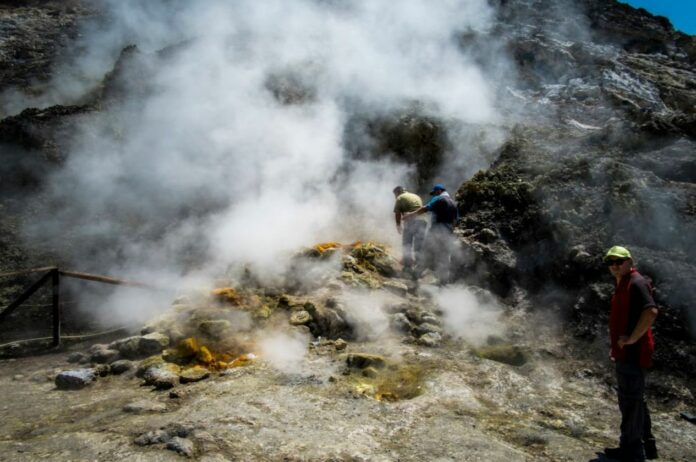Beneath Italy’s Surface, Campi Flegrei Volcano Teeters on the Edge of Eruption
Closer to rupture than ever before, the Campi Flegrei volcano, Europe’s most dangerous supervolcano, poses a significant risk, as scientists warn of its increasingly fragile state.
Campi Flegrei, the closest active volcano to London and Europe’s most dangerous supervolcano, shows significant signs of distress as new research warns of an increasingly likely eruption.
Researchers from University College London (UCL) and the Italian National Research Institute for Geophysics and Volcanology (INGV) suggest that Southern Italy’s Campi Flegrei volcano has grown increasingly frail and rupture-prone, thus raising the likelihood of an eruption.
This volcano, which last experienced an eruption in 1538, has shown unsettling signs of activity over the past seven decades. This included intervals of escalated unrest every two years during the 1950s, 1970s, and 1980s, coupled with a decelerated period of agitation over the recent ten years. During these periods, the area was subjected to tens of thousands of minor tremors, and the coastal town of Pozzuoli observed a significant elevation of approximately 4 meters (13 feet) – equivalent to the height of a double-decker bus.
The latest research, which appeared in the journal Nature’s Communications Earth & Environment, employed a UCL-developed model for analyzing volcanic fractures. This model was utilized to make sense of the seismic patterns and the rising ground, leading researchers to conclude that certain segments of the volcano have been strained to near-breaking limits.
The findings of the study confirm “that Campi Flegrei is moving closer to rupture,” warns Principal investigator Professor Christopher Kilburn.
“However, this does not mean an eruption is guaranteed.”
For an eruption to occur, the magma needs to exert upward pressure at the precise spot where the rupture could potentially form a fissure in the Earth’s crust.
“This is the first time we have applied our model, which is based on the physics of how rocks break, in real-time to any volcano.
“Our first use of the model was in 2017 and since then Campi Flegrei has behaved as we predicted, with an increasing number of small earthquakes indicating pressure from below.
“We will now have to adjust our procedures for estimating the chances of new routes being opened for magma or gas to reach the surface.
“The study is the first of its kind to forecast rupture at an active volcano. It marks a step change in our goal to improve forecasts of eruptions worldwide.”
The findings “show that parts of the volcano are becoming weaker. This means that it might break even though the stresses pulling it apart are smaller than they were during the last crisis 40 years ago,” adds Dr. Nicola Alessandro Pino.
London’s nearest active volcano, Campi Flegrei, doesn’t immediately resemble a typical volcano. Rather than forming a traditional mountainous peak, it presents itself as a wide, gentle depression spanning 12-14 km (7.5-8.5 miles), known as a caldera, which accounts for the 360,000 residents dwelling atop it.
In recent years, Pozzuoli, located beneath the volcano, has experienced a steady, creeping rise at an annual rate of approximately 10 cm (4 in). Alongside this, minor but constant seismic activities, unseen since the mid-1980s, have been observed. In April alone, over 600 such tremors were recorded, marking the highest monthly total to date.
These disturbances can be attributed to the movement of fluids, potentially magma or volcanic gases, situated roughly 3 km (2 miles) below the Earth’s surface. The ongoing period of unrest is likely due to magmatic gases filling cavities in the rocky strata, effectively saturating the 3 km-thick crust in a manner reminiscent of a sponge.
The occurrence of these earthquakes is triggered when the crust’s faults (or cracks) slide as a result of the crust being stretched. The seismic activity pattern observed since 2020 indicates the rock is exhibiting a non-flexible response, snapping under stress rather than flexing.
“We cannot see what is happening underground,” adds Dr. Stefania Danesi.
“Instead, we have to decipher the clues the volcano gives us, such as earthquakes and uplift of the ground.”
The research team underscored in their report that the unrest Campi Flegrei has experienced since the 1950s has a compounding effect. Thus, potential future eruptions could be signaled by less pronounced signs, such as minor ground uplift and fewer tremors. A comparable situation occurred in 1994 with the Rabaul caldera eruption in Papua New Guinea, which was preceded by small-scale seismic activity at a tenth of the frequency experienced during a crisis a decade prior.
According to the researchers, the current tensile resilience of Campi Flegrei, which refers to the maximum strain it can endure before fracturing, is likely just one-third of its strength in 1984.
However, the team emphasized that an eruption is not a foregone conclusion.
“It’s the same for all volcanoes that have been quiet for generations. Campi Flegrei may settle into a new routine of gently rising and subsiding, as seen at similar volcanoes around the world, or simply return to rest,” adds Dr. Stefano Carlino.
“We can’t yet say for sure what will happen. The important point is to be prepared for all outcomes.”
Going forward, Professor Kilburn and colleagues plan to apply the UCL model of volcanic fracture analysis to other volcanoes that have recently become active after long dormancy periods. The aim is to devise more dependable criteria for determining the likelihood of an eruption. At present, eruption predictions primarily rely on statistical data specific to each volcano rather than universal principles that can be generalized across multiple volcanoes.
Source: 10.1038/s43247-023-00842-1
Image Credit: Giuseppe Ciccia/NurPhoto via Getty Images
